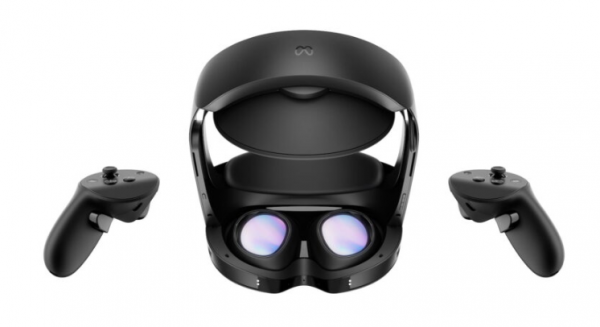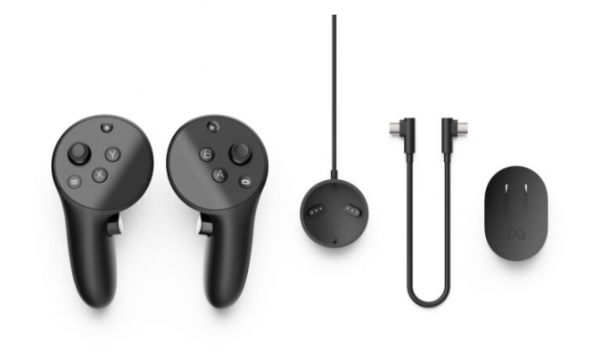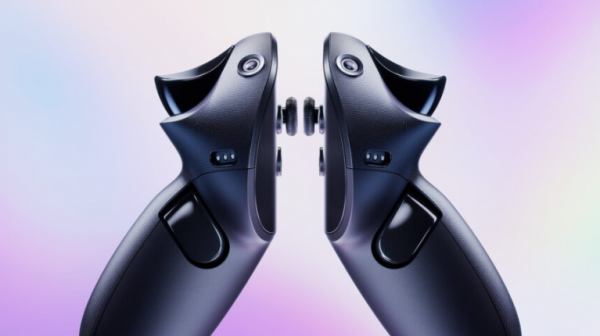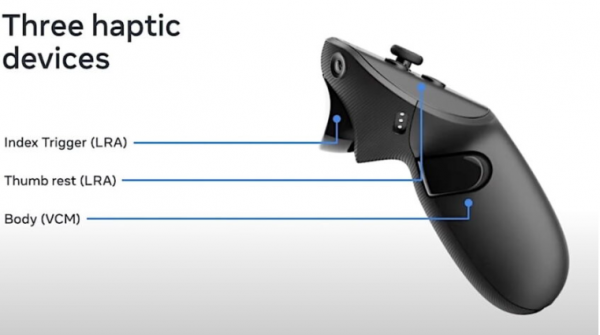Meta’s New Touch Pro Controllers Offer a Number of Improvements
The Touch Pro controllers will be bundled with the Meta Quest Pro headset. However, they are also sold separately as an upgrade to the Meta Quest 2 headset. The controllers come with a number of improvements. Let’s have a look at some of these.

Meta has referred to the new controllers as a major upgrade over the Quest 2 Touch Controllers. Below is a look at the Touch Pro specifications: –
Integrated Battery
The Touch Pro controllers weigh only 153 grams and feature an integrated rechargeable battery. Rather than having to change the battery, this input device can easily be charged with its included charging station. The Meta Quest Pro also comes with a charging cable used specifically for the new controllers. When the Touch Pro is purchased separately, it ships with an included mini charging station.

Meta says the Touch Pro controllers can last up to 8 hours based on how intensively they are used along with the VR apps they are used with. Meta’s John Carmack and Andrew Bosworth issued statements on Twitter suggesting the input device has a battery life of 4 hours.
Integrated Tracking
The biggest improvement in the Touch Pro controllers is their ability to track themselves independently using their integrated cameras. The Touch Pro controllers pack a Snapdragon 662 chip for data processing. Meta says the Touch Pro’s CPU is up to 80% faster compared to that of a Meta Quest 1. Its independent tracking functionality also relieves the headset.

The Touch Pro controllers’ ability to track themselves bestows a number of advantages. They will be spatially tracked even if there is no visual contact with the sensors located in the headset, such as in tracking under a table or behind the back. Controllers that can locate themselves do not need tracking rings which gives them a better form factor. Besides, these controllers can also be used closer together without any interference from the other. This was not possible with the previous Touch controllers. Such functionality could unlock new forms of interaction because VR developers no longer have to factor in the physical distance between the controllers.
In the future, self-tracking will also allow for VR controllers and hand tracking to be used simultaneously.
Powerful Haptic Units
The Touch Pro controllers also feature a new haptic system. Meta calls it TruTouch Haptics. Previously Touch Controllers were only equipped with an integrated single LRA (Linear Resonant Actuator) haptic unit for each of the controllers. The Touch controllers, on the other hand, have an LRA unit for its trigger, a second LRA unit positioned on the thumb rest as well as a VCM (Voice Coil Monitor) unit for its grip. As a result, every controller has a total of three haptic units.

The two LRA units in the Touch Pro controllers simulate the haptic effect at stipulated locations. Meta says the VCM unit provides “the most complex and realistic effects” so far in the market.
New Sensors and Interactions
Apart from the controllers’ dedicated haptic unit, there is also a new sensor in the trigger button that can detect the flexing or sliding motion of the user’s index finger.
The Touch Pro controller is capable of detecting the extent to which the finger is bent before it presses the shutter button. It will also detect uniaxial sliding motion. Check the video below for an illustration of this functionality.
The Touch Pro controller’s thumb rest is slightly beveled and it also includes an extra sensor, like the trigger. There is a pressure sensor capable of measuring up to 6 Newtons of force.
The trigger button sensor enables the controller to provide an intuitive pinch or twist interaction by selectively together the thumb and index finger.
Another form of interaction is realized through the firm press of the thumb pad. This enables extra pressure to be applied to a virtual object to perform actions such as breaking or squeezing it. Developers can leverage the various degrees of up and down movement for their apps through an interface.
The Touch Pro Controller Can Also Be used as a VR Pen
The Touch Pro controllers’ wrist straps are removable and replaceable with pen-like rubber tips. When the controllers are flipped over, they can be used as a pen to sketch or write on a VR whiteboard.
The pressure sensor integrated at the end of the Touch Pro’s controllers’ grips can detect how hard the user presses against a physical base or surface and can register up to 2 Newtons of force impact.
The separate Touch Pro controllers will be available for sale this year and could be a potential controller upgrade even for the Meta Quest 2 headset. They cost $299.
https://virtualrealitytimes.com/2022/10/21/metas-new-touch-pro-controllers-offer-a-number-of-improvements/https://virtualrealitytimes.com/wp-content/uploads/2022/10/One-of-the-controllers-three-cameras-and-charging-contacts-600x336.pnghttps://virtualrealitytimes.com/wp-content/uploads/2022/10/One-of-the-controllers-three-cameras-and-charging-contacts-150x90.pngBusinessHardwareThe Touch Pro controllers will be bundled with the Meta Quest Pro headset. However, they are also sold separately as an upgrade to the Meta Quest 2 headset. The controllers come with a number of improvements. Let’s have a look at some of these. Meta has referred to the new...Rob GrantRob Grant[email protected]AuthorVirtual Reality Times - Metaverse & VR
